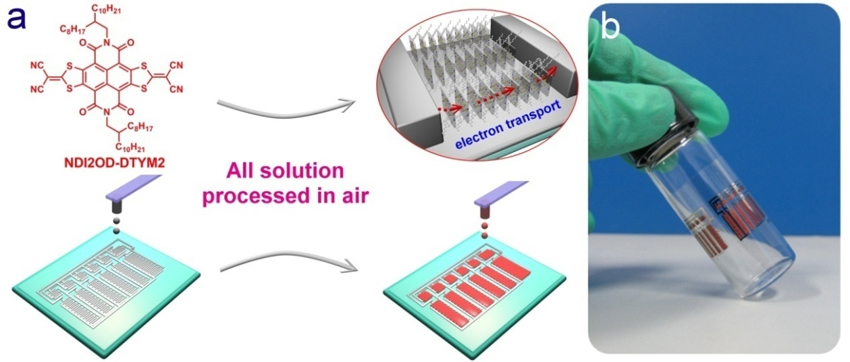| GIXRD has played an important role in the characterization of organic thin-film transistors |
| From: PublishDate:2011-08-30 Hits: |
As an alternative to well-established amorphous silicon electronics for low-cost, large-area, and flexible applications, organic thin-film transistors (OTFTs) have made great achievements in the past two decades. Building on this rapid progress, organic circuits have been successfully demonstrated in various areas such as electronic papers, sensors, and radio frequency identification cards (RFID). A promising development for OTFTs, driven by the urgent demand for ultra-low-cost printed and ambient electronics, is the realization of all-solution-processed complementary circuits composed of both p-channel and n-channel devices. Compared with those exciting reports on solution-processed p-channel transistors with mobility approaching 1.0 cm2V−1s−1, only a few solution-processed n-channel OTFTs showing mobilities exceeding 0.1 cm2V−1s−1 have been fabricated, despite many innovative studies of material design and device engineering. This uneven development makes the fabrication of high-performance, solution-processed n-channel organic transistors one of the biggest remaining challenges. Due to the intrinsic nature of electrons being trapped by oxygen, the low air-exposed performance and stability is a key issue for n-channel OTFTs, especially for solution-processed ones. Therefore, most reported solution-processed n-channel OTFTs suffer from relatively low performance (with mobilities < 0.2 cm2V−1s−1) and stability for the bottom-gate devices where the active layer exposed to air, which presents an obvious contrast with the excellent result for solution-processed top-gate devices. Recently, researchers in Key Laboratory of Organic Solids, Institute of Chemistry and Laboratory of Materials Science, Shanghai Institute of Organic Chemistry, Chinese Academy of Sciences make great progress in this field. They developed a bottom-gate device based on a core-expanded naphthalene diimide fused with 2-(1,3-dithiol-2-ylidene)malonitrile groups (NDI2ODDTYM2) presenting a high electron mobility of up to 1.2 cm2V−1s−1 in air (Figure 1). More excitingly, the outstanding stability of NDI2OD-DTYM2 enables the devices to both endure the high temperature annealing treatment during fabrication and to maintain high performance even when operating at high environmental temperatures (≤120 ° C) under ambient conditions.
Figure 1. a) Illustration of the chemical structure of NDI2OD-DTYM2, fabrication processes, and device structure of n-channel OTFTs. b) Optical images of an all-solution-processed flexible organic oscillator fabricated under all-ambient environment.
In order to discuss the relationship between the performance and the structure, grazing incidence X-ray scattering (GIXRD) is used as an important method to investigate in detail the microstructure of the film. The in-plane structure of the annealed NDI2OD-DTYM2 film was investigated using GIXRD in Beijing Synchrotron Radiation Facility (BSRF) to probe the crystalline planes, which were oriented perpendicular to the dielectric layer. The annealed film at 170 °C showed a short π-stacking distance of 3.47 Å (Figure 2). This π-stacking distance is comparable to the values reported for the excellent naphthalene tetracarboxylic-diimide-based semiconductors. The close packing of the π -planes, together with the protection afforded by the long-branched N-alkyl chains, inhibits the ingress of oxygen, which effectively reduces the occurrence of electron trapping. This, combined with the low energy of the lowest unoccupied molecular orbital (LUMO), is responsible for the excellent device performance and outstanding device stability.
Figure 2.In plane grazing incidence X-ray characterization of NDI2OD-DTYM2 film annealed at 170 °C. This result was published in Advanced Materials (Adv. Mater. 2011, 23, 2448-2453) and was selected as cover. It was also selected as the Hot Topic paper in the field of Organic Electronics.
Figure 3. The result was published in Advanced Materials and was selected as cover. |
|
|
| Chinese
- Synthesis of High Performance Polymer Materials for Field Effect-Transistors
- Surfactant molecular aggregates in green solvents
- GIXRD has played an important role in the characterization of organic thin-film transistors
News and Events
Home /
Copyright © 2011 - 2012 Beijing Synchrotron Radiation Facility




